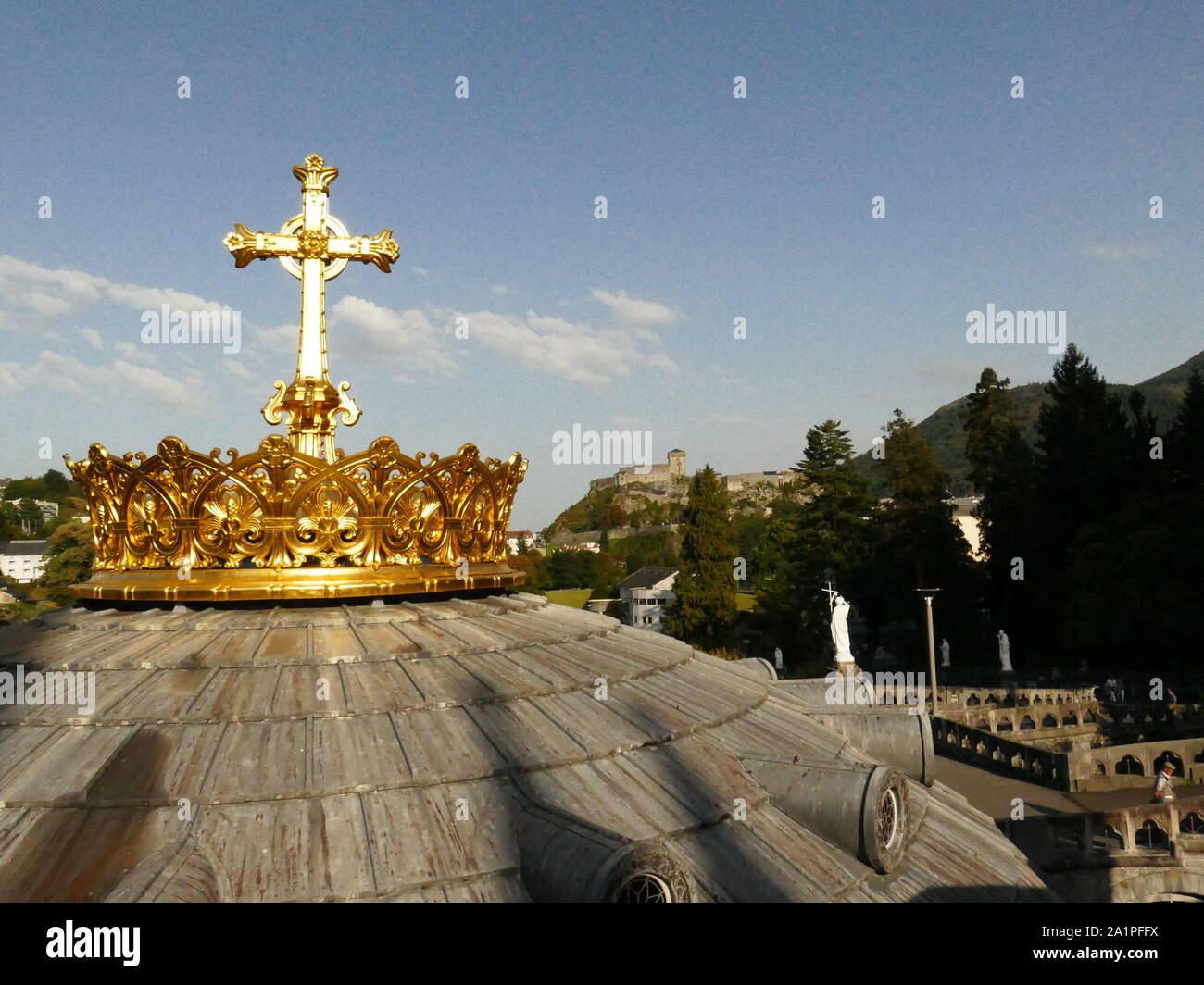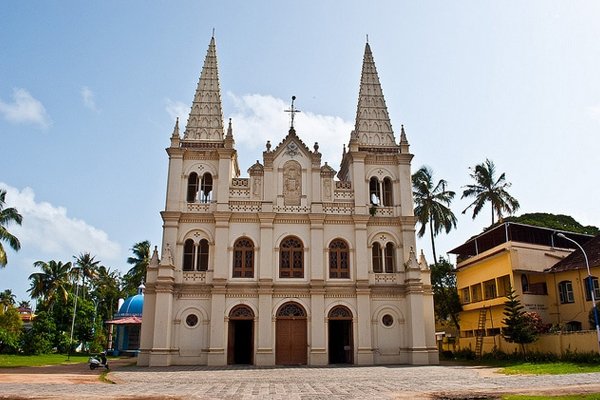Christian pilgrimage centers hold deep significance for believers. They offer a chance to connect spiritually with sacred sites.
Pilgrimage has been a vital part of Christian faith for centuries. Visiting these centers can be a transformative experience, fostering a deeper connection to religious heritage. From the ancient streets of Jerusalem to the peaceful shrines in Lourdes, each destination has a unique story and spiritual essence.
Pilgrims often seek solace, healing, and enlightenment at these holy places. Whether you’re planning your first pilgrimage or exploring new destinations, understanding the importance of these centers can enrich your journey. In this blog, we’ll explore various Christian pilgrimage centers that can inspire and uplift your faith.

Credit: www.alamy.com
Historical Significance
Christian pilgrimage centers have a rich historical significance. These sites have been visited for centuries. They hold deep spiritual meaning. Pilgrims travel to these places seeking connection. Many believe these journeys strengthen faith.
Understanding the history of these centers reveals their importance. They are often linked to key events in Christianity. This history shapes the experiences of modern pilgrims. It provides context for their spiritual journeys.
Ancient Sites
Ancient pilgrimage sites like Jerusalem are vital. They are associated with Jesus Christ’s life. The Church of the Holy Sepulchre in Jerusalem is significant. Christians believe it is where Jesus was crucified and resurrected.
Other ancient sites include Bethlehem. Bethlehem is known as Jesus’ birthplace. Pilgrims visit the Church of the Nativity there. Nazareth is another important site. It is where Jesus spent his childhood.
These ancient locations attract pilgrims worldwide. They offer a glimpse into early Christian history. Visiting them can be a profound spiritual experience.
Modern Pilgrimage Trends
Modern pilgrimage trends show a shift. More people now visit lesser-known sites. Places like Lourdes in France have gained popularity. Lourdes is famous for its healing waters. Many believe in its miraculous powers.
Fatima in Portugal is another trending site. It is known for the apparitions of the Virgin Mary. Pilgrims find solace and inspiration here. Santiago de Compostela in Spain attracts many hikers. They walk the Camino de Santiago route.
Modern pilgrims seek diverse experiences. They blend spiritual practices with personal reflection. These trends reflect a broader understanding of pilgrimage. They show how the practice evolves with time.

Credit: www.tourmyindia.com
Popular Pilgrimage Locations
Christian pilgrimage centers hold great significance for believers around the world. These sacred sites offer spiritual renewal and a deeper connection to faith. Here, we explore some of the most popular pilgrimage locations that draw millions of pilgrims each year.
Jerusalem
Jerusalem is a key pilgrimage site for Christians. It is where Jesus lived and preached. The Church of the Holy Sepulchre is a major attraction. Believers hold it as the site of Jesus’ crucifixion and resurrection. The Via Dolorosa is another important path. It represents the route Jesus took on his way to crucifixion.
Visitors to Jerusalem can also explore the Garden of Gethsemane. This is where Jesus prayed before his arrest. The Mount of Olives offers a panoramic view of the city. It is also significant in biblical prophecy. Walking through Jerusalem’s ancient streets feels like stepping back in time.
Rome
Rome is central to the Christian faith. The Vatican City, within Rome, is the heart of the Roman Catholic Church. St. Peter’s Basilica is a must-see. It is one of the largest churches in the world. Pilgrims are drawn to its stunning architecture and spiritual significance. The Vatican Museums house priceless religious art and artifacts.
The Sistine Chapel is famous for Michelangelo’s ceiling. It depicts scenes from the Bible. The Catacombs of Rome are also important. Early Christians used these underground burial sites. Walking through these tunnels offers a glimpse into early Christian history. Rome’s rich history and religious heritage make it a vital pilgrimage destination.
Planning A Pilgrimage
Planning a pilgrimage to Christian centers can be a fulfilling journey. It requires careful preparation to make the trip meaningful. This involves considering travel tips, accommodation options, and other essentials.
Travel Tips
Research your destination ahead of time. Know the best time to visit. Some seasons might offer better weather. Others might have important religious events. Pack light, but carry essentials. Comfortable shoes are a must. You’ll likely walk a lot. Stay hydrated. Pilgrimages can be physically demanding.
Accommodation Options
Many pilgrimage centers offer various accommodations. You can choose from hotels, guesthouses, or hostels. Some places even have religious guesthouses. They provide a peaceful environment. Book in advance, especially during peak seasons. Check online reviews for the best options. Look for places close to the pilgrimage site. This saves travel time and energy.
Spiritual Preparation
Embarking on a Christian pilgrimage is a profound journey. This journey goes beyond physical travel. Spiritual preparation is crucial. It helps pilgrims connect deeply with their faith. It fosters a meaningful and transformative experience.
Meditation Practices
Meditation plays a significant role in spiritual preparation. It allows pilgrims to quiet their minds. Focus inward and reflect on their faith. Simple breathing exercises can help. Repeating a favorite prayer also aids concentration. These practices create a peaceful state. This makes pilgrims more receptive to spiritual experiences.
Community Support
Community support is essential during preparation. Engaging with fellow believers strengthens resolve. Sharing experiences and prayers builds a supportive network. This community can offer valuable insights. They can also provide encouragement when needed. Group activities, like Bible study, deepen understanding. They also foster a sense of belonging. This collective support enriches the pilgrimage experience.
Cultural Experiences
Christian pilgrimage centers offer more than spiritual journeys. They provide unique cultural experiences. These experiences enrich the soul and broaden the mind. Pilgrims get to immerse themselves in local traditions and vibrant festivals. The blend of faith and culture makes every visit memorable.
Local Traditions
Each pilgrimage center boasts distinct local traditions. Pilgrims can witness age-old customs and rituals. These traditions are often deeply rooted in the community’s history. They reflect the unique ways locals express their faith.
Participating in these traditions creates a deeper connection. It allows pilgrims to experience faith through the eyes of the local people. Traditions may include unique prayers, songs, or dances. They often occur in the very places where significant religious events happened.
Festivals
Festivals at pilgrimage centers are vibrant and lively. They often attract thousands of pilgrims from around the world. These festivals celebrate important events in the Christian calendar. They include processions, masses, and communal meals.
Attending a festival offers a chance to see faith in action. It brings people together in joyous celebration. The atmosphere is charged with devotion and excitement. Festivals also showcase local music, food, and crafts. This makes the experience even richer and more engaging.
Challenges Faced
Embarking on a Christian pilgrimage is a profound and transformative experience. However, it’s not without its challenges. Pilgrims often face various obstacles that test their physical endurance, safety, and overall resolve. Understanding these challenges can prepare you better for your spiritual journey.
Physical Demands
Christian pilgrimage centers often involve rigorous physical activity. Walking long distances, sometimes over rough terrain, can be exhausting. Take, for instance, the Camino de Santiago. This pilgrimage involves walking hundreds of kilometers over several weeks. Even with good physical conditioning, the daily demands can be tough.
Are you ready to walk up to 20 kilometers a day? Many pilgrims prepare by training months in advance. They gradually increase their walking distances and carry a backpack to simulate the actual pilgrimage conditions.
Hydration and nutrition are critical. You should always carry enough water and energy-boosting snacks. Remember, the goal is to maintain your energy levels and prevent fatigue.
Safety Concerns
Safety is another significant challenge. Pilgrims might travel through remote areas where medical facilities are scarce. Injuries, dehydration, or even getting lost are real risks. For example, while walking through the Judean Desert to reach monasteries, the heat can be overwhelming.
Have you considered the importance of a well-planned route? Mapping out your journey and informing someone of your plans can be lifesaving. Always have a basic first aid kit and know the locations of nearby medical facilities.
Also, be mindful of your surroundings. While most pilgrimage sites are relatively safe, pickpocketing and scams can happen. Keeping your valuables secure and staying with a group can mitigate these risks.
Facing these challenges with proper preparation and a resilient mindset can make your pilgrimage not just a journey of faith, but also a test of your physical and mental strength. Are you ready to take on the pilgrimage with these insights in mind?
Personal Reflections
When it comes to Christian pilgrimage centers, the personal reflections of those who have journeyed there offer deep insights into the transformative power these sacred sites hold. Each visit is more than just a trip; it’s a life-changing experience that stays with you forever. Below, we delve into the personal stories and life changes that many pilgrims have shared.
Testimonies
Many visitors to Christian pilgrimage centers describe their experiences in profoundly emotional terms. One pilgrim shared how visiting the Church of the Holy Sepulchre in Jerusalem helped her find peace after years of personal turmoil. She felt a deep connection to the suffering and resurrection of Jesus, which brought her immense comfort.
Another visitor to Lourdes recounted how witnessing the faith of others during the candlelight procession made him reassess his own beliefs. The collective act of devotion moved him to tears and left a lasting impression on his spiritual journey.
Life Changes
Christian pilgrimage centers have been the catalyst for many life changes. One man described how his visit to the Vatican renewed his commitment to his faith. Before the trip, he felt disconnected from his spiritual life. Standing in St. Peter’s Basilica, he felt a profound sense of purpose and recommitted himself to his faith.
Another story comes from a young woman who traveled to Santiago de Compostela. She was at a crossroads in her life, uncertain about her future. The pilgrimage gave her the clarity she needed. The long walks and moments of quiet reflection helped her understand what truly mattered to her. She returned home with a newfound sense of direction and purpose.
Have you ever wondered how a pilgrimage could change your life? The stories above are just a glimpse of the many ways that visiting these sacred sites can impact you. Consider making your own journey—you might find the answers you’ve been seeking.
Future Of Pilgrimage
Christian pilgrimage centers have been a cornerstone of faith and devotion for centuries. These sacred journeys, often filled with deep spiritual significance, continue to evolve as our world changes. The future of pilgrimage is not merely about preserving traditions but also about embracing new possibilities. How can technology enhance your pilgrimage experience? What steps can we take to ensure these journeys are sustainable for future generations? Let’s explore.
Technological Impact
Technology is reshaping the way we experience pilgrimages. Imagine using a mobile app to navigate the winding paths of the Camino de Santiago, ensuring you never lose your way. Such tools can offer real-time updates, historical insights, and even language translations, making your journey smoother and more informed.
Virtual reality (VR) is another game-changer. Can’t travel to Jerusalem? VR can bring the Holy Land to your living room. This doesn’t replace the profound experience of being there in person, but it opens doors for those who might never have the opportunity to travel. It’s a way to connect with sacred sites, enhancing your understanding and devotion from afar.
Have you ever thought about how social media impacts your pilgrimage? Sharing your journey on platforms like Instagram or Facebook can inspire others and create a sense of community. However, it also raises questions about the balance between personal reflection and public sharing. How do you maintain the sanctity of your experience while staying connected?
Sustainability
As you embark on your pilgrimage, consider its environmental impact. Modern pilgrimages must embrace sustainability. Simple choices, like using eco-friendly travel methods or supporting local businesses, can make a significant difference. Carrying a reusable water bottle or choosing accommodations that prioritize green practices are small steps with big impacts.
Have you ever participated in a community cleanup along your pilgrimage route? These initiatives are growing, helping to preserve the beauty of sacred paths for future pilgrims. Engaging in these activities can deepen your connection to the journey, knowing you’re contributing to its preservation.
Is it possible to balance tradition with sustainability? Absolutely. Many pilgrimage centers are integrating sustainable practices without compromising their spiritual essence. For instance, the Vatican has implemented energy-saving measures, and the Camino de Santiago has eco-albergues (sustainable hostels) along the way.
As you look to the future of pilgrimage, how will you incorporate technology and sustainability into your journey? The choices you make today can pave the way for a more enriched, mindful, and responsible pilgrimage experience. What steps will you take to ensure that these sacred journeys continue for generations to come?

Credit: en.wikipedia.org
Frequently Asked Questions
What Are The Top Three Christian Pilgrimages?
The top three Christian pilgrimages are: 1. Jerusalem, for its biblical significance. 2. Rome, home of the Vatican and St. Peter’s Basilica. 3. Santiago de Compostela, the endpoint of the Camino de Santiago.
Where Do Christians Go For Pilgrimages?
Christians often go on pilgrimages to Jerusalem, Bethlehem, Rome, Lourdes, and Santiago de Compostela. These sites hold significant religious and historical importance.
What Is The Most Holy Place For Christians?
The most holy place for Christians is the Church of the Holy Sepulchre in Jerusalem. It is believed to be the site of Jesus’ crucifixion, burial, and resurrection.
What Is The Most Visited Christian Pilgrimage Site In The World?
The most visited Christian pilgrimage site in the world is the Basilica of Our Lady of Guadalupe in Mexico City. This sacred site attracts millions of visitors annually. Pilgrims come to honor the Virgin of Guadalupe. The basilica holds significant religious and cultural importance.
Conclusion
Christian pilgrimage centers offer profound spiritual experiences. Travelers find peace and connection. Visiting these sacred sites deepens faith and understanding. Each center has its unique history and significance. Pilgrims often return feeling renewed and inspired. Exploring these destinations enriches the soul and mind.
Consider planning a visit to experience the spiritual journey. Discover the beauty and meaning behind each pilgrimage site. Let these sacred places guide you on your faith path.
{ “@context”: “https://schema.org”, “@type”: “FAQPage”, “mainEntity”: [ { “@type”: “Question”, “name”: “What are the top three Christian pilgrimages?”, “acceptedAnswer”: { “@type”: “Answer”, “text”: “The top three Christian pilgrimages are: 1. Jerusalem, for its biblical significance. 2. Rome, home of the Vatican and St. Peter’s Basilica. 3. Santiago de Compostela, the endpoint of the Camino de Santiago.” } } , { “@type”: “Question”, “name”: “Where do Christians go for pilgrimages?”, “acceptedAnswer”: { “@type”: “Answer”, “text”: “Christians often go on pilgrimages to Jerusalem, Bethlehem, Rome, Lourdes, and Santiago de Compostela. These sites hold significant religious and historical importance.” } } , { “@type”: “Question”, “name”: “What is the most holy place for Christians?”, “acceptedAnswer”: { “@type”: “Answer”, “text”: “The most holy place for Christians is the Church of the Holy Sepulchre in Jerusalem. It is believed to be the site of Jesus’ crucifixion, burial, and resurrection.” } } , { “@type”: “Question”, “name”: “What is the most visited Christian pilgrimage site in the world?”, “acceptedAnswer”: { “@type”: “Answer”, “text”: “The most visited Christian pilgrimage site in the world is the Basilica of Our Lady of Guadalupe in Mexico City. This sacred site attracts millions of visitors annually. Pilgrims come to honor the Virgin of Guadalupe. The basilica holds significant religious and cultural importance.” } } ] }



